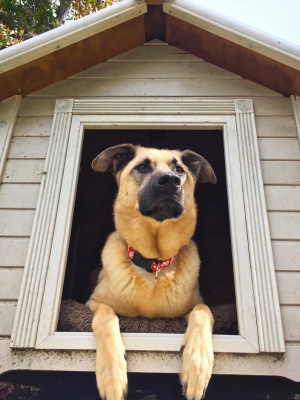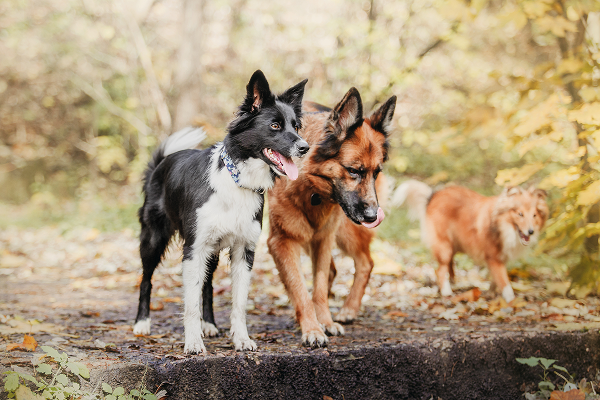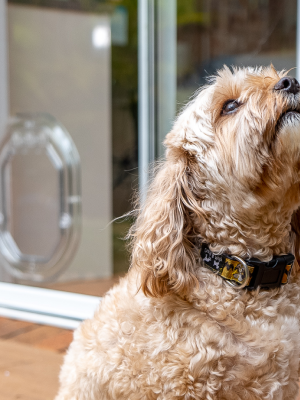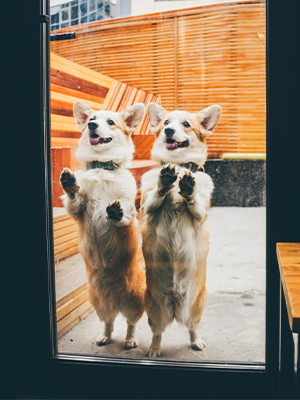
Cold weather is an unavoidable factor in keeping your dog safe, especially when they sleep outside. Chilly overnight temperatures can be a real concern, making it important to understand how to keep them warm and protected.
Our Blog
Our Blog
25/9/25
How Cold is Too Cold for Dogs to Sleep Outside?
Cold weather is an unavoidable factor in keeping your dog safe, especially when they sleep outside. Chilly overnight temperatures can be a real concern, making it important to understand how to keep them warm and protected.
Although it largely depends on your dog’s characteristics, once temperatures get below 7°C, we recommend remaining vigilant when letting your dog sleep outdoors. Important to ensure that when they do sleep outside, your dog has a warm, dry kennel, and they get enough food and water. Also helpful to be aware of any hypothermia symptoms, such as shivering, slow movement or pale body.
Continue reading to learn about the ideal temperature for your dog to sleep outside and how to ensure they stay safe and comfortable.
Can My Dog Sleep Outside?
This can be a tricky question to answer, as it really depends on the circumstances. Yes, your dog can sleep outside, but only if they have an appropriate shelter and the area is safe. Their sleeping space should be warm, dry, and well-protected from the elements, including wind, rain, and frost. Doesn’t mean every dog should sleep outside. For instance, if you have a young puppy or an unwell dog, it’s best to let them sleep indoors. These dogs are more vulnerable to cold weather, especially when their immune systems aren’t functioning at full strength.
As long as you’ve made the necessary arrangements, like proper shelter, warm bedding, and protection from the elements, your dog should be fine sleeping independently outdoors. However, if you have any concerns at all, it’s always best to bring them inside to ensure they stay safe and comfortable.
How Cold is Too Cold For Dogs?
While we don’t experience the extreme cold of some other countries, overnight temperatures in Australia can still get quite chilly. To ensure your dog stays comfortable when sleeping outside, it’s important to understand what temperatures may be too cold. As a general rule, if it feels too cold for you, it’s probably too cold for your dog. However, depending on your dog’s breed and characteristics, they may be more tolerant.
Above 10°C
At temperatures above 10°C, your dog will most likely be fine. If you are concerned about their age, breed or health, monitor them for any changes in behaviour.
Below 7°C
Once temperatures start to drop below 7°C, your dog may start to feel the negative effects of the cold. Dogs that are at higher risk of hypothermia may need to be brought inside unless their kennel has warm bedding and proper insulation. If you let them sleep outside under 7°C, ensure you monitor for any behavioural changes, and let them inside if you develop any concerns.
Below Freezing (0°C)
Once temperatures dip below freezing, we recommend bringing them inside. If you have a breed that is particularly fond of the cold, such as a Siberian Husky with a thick coat, or you have a highly insulated kennel, you may feel ok to have them outside. Just remember to take extra care with monitoring your dog, as temperatures below freezing put them at serious risk of hypothermia.
These are just general guidelines based on average temperatures. No one knows your dog better than you, so if you think it’s too cold for them, trust your instincts and bring them back inside.

Factors That Affect a Dog’s Cold Tolerance
The cold won’t affect every dog the same. The degree to which they can cope will depend upon the following factors:
Dog Breed
Dogs that originate from colder climates, such as Siberian Huskies or Burmese Mountain Dogs, with their thick coats and sturdy builds, may prefer to be in freezing conditions outside. Alternatively, some dogs are much less suitable for cold weather. Breeds with slimmer builds and thin coats, such as chihuahuas or cocker spaniels, lose body heat faster and may need extra attention.
Dog Age
Puppies and older dogs are much more susceptible to colder temperatures than middle-aged dogs. This is because they can’t generate and maintain body heat as well. Puppies may not have fully developed the body fat needed for insulation, while senior dogs have thinning coats and weaker immune systems.
Dog Size and Body Mass
Larger dogs are usually better equipped at handling colder temperatures. This is because they have more body fat and muscle, which acts as natural insulation for holding warmth. Although this shouldn’t be an excuse to let your dog gain unnecessary weight, as this comes with its own set of health risks.
Dog Health Conditions
When your dog is sick, they should not be exposed to cold temperatures. This is recommended because their immune systems may be weaker, making it more difficult for them to properly regulate body temperature. Includes dogs suffering from any heart disease or arthritis, who are a particularly high risk. Often, these dogs may even need extra help to stay warm, such as a jacket or heating pad.
Signs That Your Dog Is Too Cold
It’s essential to watch for any warning signs that your dog may be too cold if they’re sleeping outside. This is to prevent your dog from getting hypothermia, when their core temperature drops below 32°C.
Shivering
Check to see if your dog is involuntarily shaking or shivering. Similar to humans, this is from their body creating rapid muscle contractions in an attempt to raise their core body temperature.
Curled Up
When your dog is too cold, they may curl themselves up to try and conserve body heat by minimising their surface area. This is a good indicator that they are feeling too cool, particularly if your dog doesn’t usually curl up.
Seeking warmth
Your dog may be constantly seeking out sources of heat or wanting to stay indoors overnight.
Pale or Cold Body
If your dog’s skin and body feel unnaturally cold, then your dog is likely too cold. Focus in particular on the exposed parts of your dog, such as their nose, ears or paws, which may look pale and feel cold to the touch.
Lethargic movement
When your dog’s movement starts to slow, this may be a clear sign that they are too cold. This is because when exposed to cold temperatures, your dog’s physical responses slow down to conserve heat. Your dog may also appear suddenly tired or sluggish.
Severe hypothermia symptoms
When your dog’s shivering stops, this could signal a more severe case of hypothermia because their muscle cells may have run out of energy. Often accompanied by slow or erratic breathing, fixed or dilated pupils, and instances of collapse. These are serious symptoms, and your dog should be referred to a VET as soon as possible to prevent any serious complications.
What To Do If Your Dog Gets Too Cold
If you feel your dog is too cold, then you’ll need to act quickly. Usually, mild cases of hypothermia can be treated at home. Start by moving them to somewhere warm, like inside your home, and cover them with blankets or towels. Then wrap a hot water bottle or a hot pad around your dog’s belly. Ensure your heated pad or water bottle is wrapped up within the blanket, so as not to burn your dog by accident.
Avoid placing your dog in a hot bath if they are too cold. The sudden rise in temperature can actually be dangerous, as it worsens the effects of shock and could lead to burns if it gets too warm.
If you are still concerned about your dog’s well-being or you fear they may be suffering from severe hypothermia, take them to an emergency veterinarian right away. Your vet will be able to check and treat any cold-related issues and long-term effects.

How Do I Keep My Dog Warm?
To ensure your dog remains warm outside, consider the following steps:
Provide Proper Shelter
The most important thing for dogs to stay warm outside is to provide proper shelter. A well-designed kennel should protect your dog from all the elements, with enough insulation to keep them warm inside. Choose a shelter with a weatherproof roof, and face it away from any prevailing winds. Also invest in a suitable kennel that is large enough to support your dog’s size. It is important that your dog is still able to comfortably walk around, stand on their hind legs, stretch and lie down without being heavily constricted.
Make the Sleeping Area Warm and Dry
To keep your dog feeling comfortable overnight, pack your shelter with warm bedding. This could be a fleece dog bed, a fluffy mattress or simply an old blanket or doona. Multiple layers of bedding are a great way to ensure your dog stays comfortable, particularly through winter.
Food and Water
Keeping your dog properly fed and hydrated is an important step because this provides the energy necessary to keep your dog’s body at stable temperatures. Make sure you store food in a location that is not prone to temperature fluctuations and away from direct sunlight or heat, which can degrade its quality. Cold weather can also dehydrate your dog as much as hot weather. Try to ensure easy access to water that’s stored in a way so it can’t be spilled or knocked over.
Monitor Conditions and Your Dog’s Behaviour
When your dog’s outside, it’s important that you monitor their behaviour for any hypothermia-related symptoms. Also, find time to check the upcoming forecasts to see if any extreme cold or stormy weather is expected.
Install a dog door
Choosing to add a pet door could be a great solution for balancing the time your dog spends indoors and outdoors. It allows your dog to get fresh air and exercise outside, without sacrificing their need for warmth inside. For more information about pet doors and installation options for your home, give Sydney Pet Doors a call or send us an email.
What to Watch Out For When Your Dog Is Outside
Other than extreme heat, when your dog spends time outside, it’s vital to be conscious of any other potential risks. These can include the following:
Getting too hot
Although the cold is an issue during winter, in summer, your dog may overheat. Because dogs do not regulate temperature in the same way as humans, heat exhaustion and heat stroke are common issues. Ensure your dog has plenty of access to water and shade to keep them cool.
Poisonous Plants
When your dog is left to their own devices outside, they could put themselves in harm’s way. Just within your backyard garden, there are a variety of plants that could be potentially toxic. These can include sago palm, aloe, tomato plants, and ivy. Identify and remove any of these potential risks, or install a barrier like fencing between your plants and dog.
Wild animals and other dogs
Leaving your dog outside can also expose them to potential dangers from other animals, like feral dogs or snakes. Try to keep your dog’s outside area as secure as possible with proper fencing.
Any bad habits
When your dog spends significant periods outside with minimal social interaction, this may instil bad habits. Excessive barking, digging, chewing furniture, hoses or sprinklers can all develop without proper care. Being left outside can contribute to antisocial behaviours like aggression, depending on the circumstances.
Any legal consequences
When your dog sleeps outside, it’s great to be aware of any laws governing animal welfare. If you mistreat your dog or leave it outside in unsuitable conditions, you may be liable for fines or a ban on owning an animal. For example, in NSW, pet welfare is protected by the Prevention of Cruelty to Animals Act 1979 (POCTAA), which authorises RSPCA NSW to investigate cases of animal cruelty that directly affect animal welfare.
Having any pet brings with it a responsibility to create a safe and loving environment. When you choose to let your dog sleep outside, cold is a factor that needs to be addressed. Usually, anything above 10°C will be fine for your dog. However, once temperatures get closer to freezing (0°C), we recommend heavily considering the welfare of your dog and bringing them inside if needed.
Latest Posts
Latest Posts
Questions? We’re here to help.


